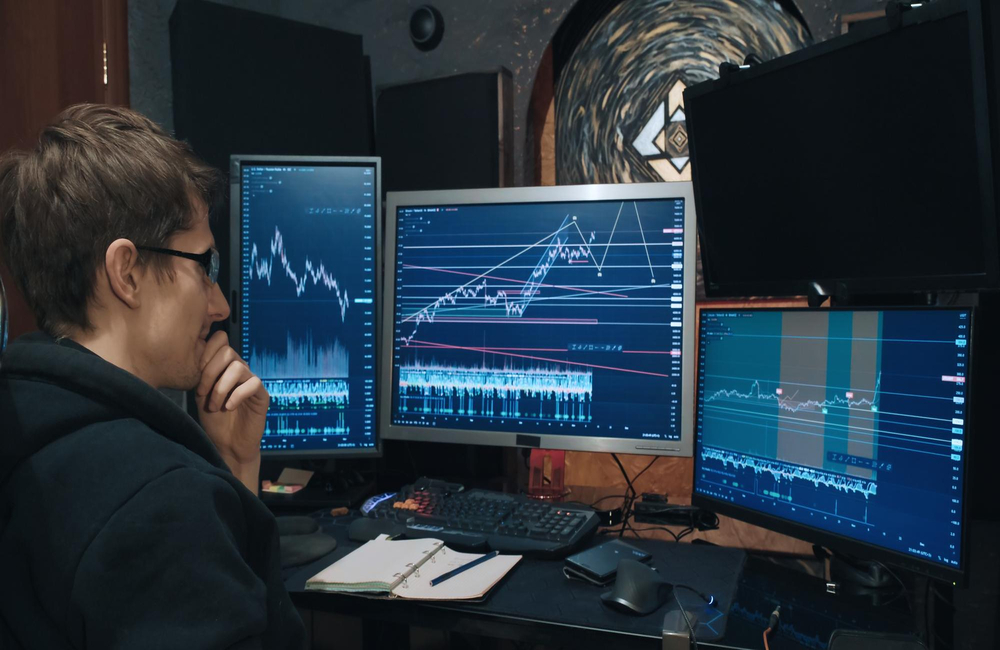The S&P 500 gained 1.4 percent and the blue-chip Dow Jones Industrial Average climbed 1.3 percent, or about 427 points. The tech-heavy Nasdaq Composite gained 1.9%. The S&P 500 opened the week with small losses Monday.
China’s largest covid explosion in two years is introducing more volatility to a global economy that’s already grappling with Russia’s invasion of Ukraine and record high inflation.
LOCKDOWNS: Shuttering of major Chinese manufacturing centers threatens more mayhem for supply chains. The possibility of weaker demand from the world’s biggest commodity buyer helped drive commodity prices lower this week, easing energy price inflation.
“You currently have this negative correlation where when oil goes up, the market goes down and when oil goes down the market goes up,” said Jack Janasiewicz, lead portfolio strategist for Natixis Investment Managers Solutions. “If you can get oil to settle down to where it was pre invasion, that gives us a bit more confidence that inflation isn’t running away and making things more problematic for the Fed."
Russian and Ukrainian leaders on Monday concluded peace talks after a second day of negotiations, which ended with no sign of a breakthrough. In a separate show of support for the Ukrainian government, leaders of the Polish, Slovenian and Czech governments traveled to Kyiv late on Tuesday.
Locally, the S&P/ASX 200 slumped 0.7% to close at 7097.4 on Tuesday on weaker commodity stocks. Iron-ore, gold and energy stocks were all weaker on a pullback in commodity prices.
The tech sector fell after a weak lead from the Nasdaq Composite, which also touched a 52-week low.
Rio Tinto, BHP and Fortescue lost between 3.9% and 4.9% as the materials sector posted its heaviest single-day loss in three weeks. Gold miners took similar hits. Energy stocks including Woodside, Santos and Beach fell 2.85% to 5.0%.
Financial stocks reduced the overall declines as banks ANZ, NAB, Westpac and Commonwealth rose 0.4% to 1.75%.
In commodities markets, gold futures eased 2.3% to $1916.10; Iron ore lost 6.5% to US$144.55 a tonne; and Brent crude collapsed below US$100 for the first time since 1 March, down 7.9% at US$98.47.
Bond markets are bracing for this week’s interest rate decision by the Federal Reserve, due Thursday morning AEST. The US 10-Year Treasury Note fell from its earlier rally, with yields flat at 2.14%. The yield on the 10-year Australia bond rose to 2.51%. Yields rise when prices fall.
The Australian, which steadied overnight after two days of losses, was at 71.93 US cents at 8:00 am AEST, compared with last close of 71.85. The WSJ Dollar Index, which tracks the US dollar against 16 peers, climbed again to 91.91, its most valuable level in 5+ years outside of the three months after March 2020.
Asia
Chinese stocks dropped sharply in the session, part of a selloff as the country continued to report sharply higher Covid-19 infections after two years of near-zero cases. The benchmark Shanghai Composite Index fell 4.9%, and Shenzhen Composite Index dropped 4.6%. The ChiNext Price Index fared relatively better as it declined 2.6%.
Stocks tied to oil, such as services companies for the oil industry and engineering services, sank as crude prices retreated. Gold prices were down as profit-taking weighed on prices, dragging precious metal miners lower.
Shares in Hong Kong ended lower with the benchmark Hang Seng Index 5.7% lower at the close, bringing one-month declines to 25%. Investors are zeroing in on China’s Covid-19 situation, which is seeing curbs in Shenzhen and Shanghai triggering concerns that lockdowns could widen, a development that would weigh on growth, Oanda said.
There was also rotation from value stocks to growth stocks, adversely affecting Hong Kong equities, it said. Losses were across the board, with Longfor Group leading a fall of 15%, followed by Country Garden Services, Ping An Insurance and Sands China, each down 13%, 13% and 12%, respectively.
Japanese stocks closed higher, led by auto stocks, taking cue from declining crude oil easing cost concerns of fuel and raw materials. The yield on the 10-year Japanese government bond jumped 1.5 basis points to 0.205% as financial stocks advance after the central bank of the United States kicks off a two-day policy meeting later in the day.
Elsewhere, energy and mining stocks slide, continuing to lose some of their recent gains. Inpex falls 6.8% and Sumitomo Metal Mining sinks 10%. The Nikkei Stock Average climbs 0.2%.
Europe
European markets ended slightly lower as lower oil and metal prices weighed on stocks. The pan-European Stoxx Europe 600 fell 0.3 percent.
“European markets have backed off slightly, but Wall Street put some distance between itself and the news, even as the focus moves steadily toward tomorrow’s Fed meeting,” the IG analyst Chris Beauchamp says. “The prospect of tighter monetary policy and the ongoing war in Ukraine are pressuring markets.” Falling commodity prices haven’t helped.”
In London, the FTSE 100 ended Tuesday down 0.32 percent, as concerns over tighter monetary policy and the ongoing war in Ukraine weighed on markets further.
“A weaker start to the day has at least been largely unwound for European indices, including the FTSE 100, though for the moment these markets remain penned in below last week’s peaks as the bullish momentum quakes in its boots,” says Beauchamp. So do weaker commodity prices, which weighed on the likes of Glencore PLC and Antofagasta PLC, along with concerns about a wider lockdown in China that have hit markets, too, Mr. Beauchamp says.
North America
US stocks rose on Tuesday after a decline in oil prices soothed investors’ worries about inflation and the possibility that the Federal Reserve will act more forcefully to raise interest rates.
Oil’s drop came as investors awaited the Fed’s decision Wednesday, which is widely anticipated to raise rates for the first time since 2018. Russia’s invasion of Ukraine had sent prices on the commodity soaring well above $100 a barrel, raising stakes for the US economy and its central bank.
The S&P 500 gained 1.4 percent, and the blue-chip Dow Jones Industrial Average climbed 1.3 percent, or roughly 427 points. The technology-focused Nasdaq Composite gained 1.9%. The S&P 500 was down modestly Monday to kick off the week.
Oil prices fell back below $100, reversing a large share of the price spike following Russia’s invasion of Ukraine. West Texas Intermediate, the US benchmark, fell more than 8 percent to $94.69 a barrel. The international benchmark, Brent crude, dropped more than 7 percent to $98.59 a barrel.
Delta Air Lines, United Airlines Holdings and other US airline shares turned higher. Demand for air travel has rebounded faster than many US airline executives had anticipated, they said at an investor conference Tuesday. The pickup has enabled the carriers to raise fares and eliminate less-profitable flights, steps that have helped them absorb rising jet-fuel costs.
Energy stocks declined, and the energy sector of the S&P 500 fell nearly 4 percent. Occidental Petroleum, Marathon Oil and Halliburton all gave back at least 3%.
“You’ve got this negative correlation right now where you have oil moving up and the market moving down, and oil moving down and the market moving up,” said Jack Janasiewicz, lead portfolio strategist for Natixis Investment Managers Solutions. “If you can get oil to settle down to pre invasion levels, that gives us just a little bit more confidence that inflation is not going off on the front-end and making life more challenging for the Fed.”
Oil prices retreated as investors assessed what Beijing’s dramatic Covid-19 lockdowns will mean for demand.
Chinese indexes dropped, deepening a recent rout that was fed by rising Covid-19 cases in the country, renewed regulatory pressure from Beijing and the threat of U.S. delistings of Chinese shares. China’s daily number of cases more than doubled, the government said Tuesday, in an outbreak that has forced lockdowns in multiple big cities and an entire province.
An increasingly rich clampdown on travel and retail spending in China, alongside supply-chain disruptions, is yet another complication for a global economy that is already coping with the war in Ukraine and the highest inflation in a generation.
“The headlines that Covid is swirling through out China is yet another thing that adds to uncertainty in the global markets because it raises fears of supply chain disruptions,” said David Donabedian, chief investment officer at CIBC Private Wealth.
Shares of Nvidia, Advanced Micro Devices and other chip makers also advanced as investors rushed into technology companies more sensitive to the outlook for the economy. Information-technology stocks, as a group, racked up the largest gains in the S&P 500.
Fed officials are scheduled to meet Tuesday, kicking off a two-day policy meeting that is taking place against a backdrop of 40-year-high inflation and fears that Russia’s invasion could harm global economic growth. And though the Fed’s on course to implement its plans for a cycle of rate hikes starting with a quarter-percentage-point jump on Wednesday, investors are seeking guidance on how the war underway in Ukraine could affect the pace of tightening ahead.
European leaders were en route to Kyiv on Tuesday to visit Ukraine’s president and present him with a sweeping package of support for his country. In the meantime, Russia was still launching missiles at the capital city.
U.S. Treasury yields eased before the meeting after climbing to their highest level in more than 2 1/2 years on Monday. The yield on the benchmark 10-year note declined to 2.122% from 2.139% on Monday. Bond prices and yields move in opposite directions.
Investors were also weighing new data on producer prices. The producer-price index, which typically tracks supply conditions, increased a seasonally adjusted 0.8% in February, the Labor Department said, down from an upwardly revised 1.2% gain in January.
Investors interpreted the fall in oil prices and a slowdown in producer prices as indicating the Fed may not have to raise interest rates aggressively to keep inflation at bay, said Tim Murray, capital market strategist for T. Rowe Price Group Inc.
“If lower oil translates to lower inflation, hopefully that means a lower end point for Fed tightening,” Mr. Murray said. “The rates are the No. 1 issue for U.S. stocks.”
Investors had worried that the Russia-Ukraine conflict would drive inflation even higher by cutting off Russia’s large supplies of oil and gas and snarling deliveries of key metals and grains. They fear the shock may squeeze the growth of the global economy at a moment when it is getting over the fallout of Covid-19 lockdowns.
“The main problem for investors is that the invasion of Ukraine is fueling inflation that was already concerning, but also creates uncertainty for the outlook of economic growth,” Mr. Donabedian said. “It’s a one-two punch in raising uncertainty.”
Compounding that uncertainty is the threat of an escalation itself, with the latest diplomatic efforts at ending the fighting showing little movement. Investors are starting to get more anxious that a conflict that many thought wouldn’t happen just weeks ago could now extend beyond Ukraine’s borders, Mr. Donabedian said.

























